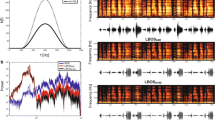Abstract
Amplitude-modulated (AM) and frequency-modulated (FM) elements are prominent periodic sound features of squirrel monkeys’ twitter calls. To investigate how the periodic FM elements are represented in the spike activity of cortical neurons, single units in the insula, primary auditory field (AI) and rostral auditory field (R) were recorded. In five monkeys, 566 units (insula, n=181; AI, n=221; R, n=164) were exposed to synthesized fundamental frequencies and one natural twitter call. Neuronal encoding of periodic FM elements takes place by phase-locking to either the up- or the down-directed FM sweeps. The phase-locking was strongly influenced by the FM-period repetition rate. The ability of neurons in both auditory fields and the insula to encode all periodic FM elements showed a marked reduction at 16 Hz FM-period repetition rate. The neurons’ best frequency (BF) influenced the quality of periodicity encoding, but neurons with BFs outside the frequency range of the fundamentals also responded with periodic discharge rates. Even neurons in AI (6.8%) and the insula (22.6%) that did not respond to pure tones showed clear periodic FM encoding. The percentage of neurons able to encode all periodic FM elements within the twitter fundamental was significantly higher in field R than in AI and the insula. From 58 simultaneously recorded pairs of units in AI and the insula that had positive cross-correlation coefficients of spontaneous activity, the influence of the FM-period repetition rate on neuronal correlation was investigated. Correlated firing of AI and insula neurons seems limited to low-period repetition rates. The cross-correlation coefficients obtained for spontaneous activity and six different periodic FM sounds showed a band-pass characteristic. The natural twitter call evoked stronger neuronal responses in all fields than the synthesized fundamental frequencies with corresponding bi-directional FM sweeps. The better encoding of the transient features in the natural call can be attributed to the amplitude modulation added to the FM elements in the natural call. These amplitude modulations divide the FM elements of twitter calls into syllable-like sound elements. It is probable that encoding the complex pattern in the time and frequency domains of a call must undergo some integration at a cortical level. Additionally, these data provide the first evidence that insula neurons contribute to the encoding of complex FM signals.
Similar content being viewed by others
Author information
Authors and Affiliations
Additional information
Received: 11 April 1997/ Accepted: 6 May 1998
Rights and permissions
About this article
Cite this article
Bieser, A. Processing of twitter-call fundamental frequencies in insula and auditory cortex of squirrel monkeys. Exp Brain Res 122, 139–148 (1998). https://doi.org/10.1007/s002210050501
Issue Date:
DOI: https://doi.org/10.1007/s002210050501




